
Boston's Old City Hall was home to its city council from 1865 to 1969. It was one of the first buildings in the French Second Empire style to be built in the United States. After the building's completion, the Second Empire style was used extensively elsewhere in Boston and for many public buildings in the United States, including the Eisenhower Executive Office Building in Washington, D.C., Providence City Hall in Providence, Baltimore City Hall in Baltimore, and Philadelphia City Hall in Philadelphia. The building's architects were Gridley James Fox Bryant and Arthur Gilman.

The Levi F. Warren Jr. High School is a former public junior high school building located at 1600 Washington Street, in the village of West Newton, in Newton, Massachusetts. It was named for Levi F. Warren, who graduated in 1854 from what is now Bridgewater State College and taught 21 years in grammar schools in Salem and in Newton, where he was a principal in West Newton.

The Seth Adams House is a historic house at 72 Jewett Street, in the Newton Corner village of Newton, Massachusetts. Probably built in the mid-1850s, it is a well-preserved example of Italianate architecture. During the 1870s it was home to Seth Adams, one of Newton's wealthiest residents. The house was listed on the National Register of Historic Places in 1986.
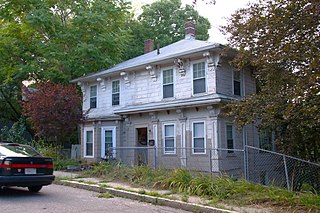
The House at 68 Maple Street is an historic building located on the corner of Maple Street and Nonantum Road in the village of Newton Corner, in Newton, Massachusetts. Built in the late 1840s, the two-story wood-frame building is a rare local example of a vernacular square hip-roofed Italianate house. Its most prominent features are its overscaled brackets, which decorate both the extended eaves and the roof line of the bay on the front facade.

The Henry Bigelow House is a historic house in the Newton Corner village of Newton, Massachusetts. Built about 1830, it is a good local example of Greek Revival architecture, important as home to Henry Bigelow, a prominent local educator and philanthropist. On September 4, 1986, it was added to the National Register of Historic Places.
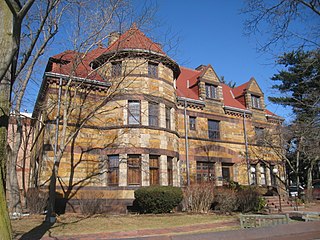
The Edwin Abbot House, also known as the Zabriskie House, is an historic house at 27 Garden Street in Cambridge, Massachusetts. Built in 1889 to a design by Longfellow, Alden & Harlow, it is a prominent local example of residential Richardsonian Romanesque architecture. It has served as the principal building of the Longy School since 1937. It was listed on the National Register of Historic Places in 1979, and included in the Follen Street Historic District in 1986.

The First Parish Church is a historic church at 50 Church Street in Waltham, Massachusetts, whose Unitarian Universalist congregation has a history dating to c. 1696. The current meeting house was built in 1933 after a fire destroyed the previous building on the same site. It is a Classical Revival structure designed by the nationally known Boston firm of Allen & Collens. The church building was listed on the National Register of Historic Places in 1989.

The Johnson School is a historic former school building on School Street in North Adams, Massachusetts. Built about 1898, this Romanesque Revival school is a significant work of the prominent local architect Edwin Thayer Barlow. It was the last of the city's neighborhood schools to be closed. The building was added to the National Register of Historic Places in 1985. It is now used for Head Start and other social programs.

The Edwin Bassett House is a historic house in Reading, Massachusetts. It is a well-preserved Greek Revival house, built in 1850 by Edwin Bassett, the first Reading shoemaker to install a McKay stitching machine, a device that revolutionized and led to the industrialization of what was before that a cottage industry. The house was listed on the National Register of Historic Places in 1984.
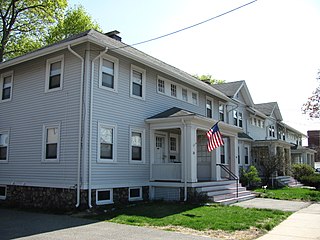
The building at 38–48 Richardson Avenue is a historic residential rowhouse in Wakefield, Massachusetts. Built c. 1912, is believed to be one of the oldest rowhouses in the town. They were built by Solon O. Richardson, Jr., on a portion of his family's estate. The building was listed on the National Register of Historic Places in 1989.
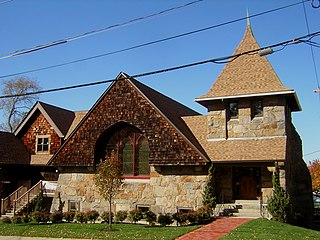
The Wollaston Unitarian Church, more recently a former home of the St. Catherine's Greek Orthodox Church, is a historic church building at 155 Beale Street in Quincy, Massachusetts. Built in 1888 to a design by Edwin J. Lewis Jr., it is a prominent local example of Shingle Style architecture. It was added to the National Register of Historic Places in 1989. The building has been converted to residential use.
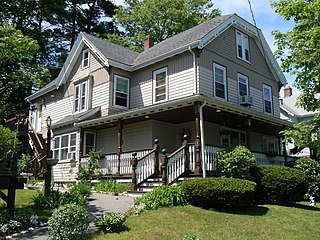
The Newton Lamson House is a historic house at 33 Chestnut Street in the Nobility Hill section of Stoneham, Massachusetts. Built c. 1887, it is one of Stoneham's finest Queen Anne/Stick style houses. It has a rectangular plan, with a gable roof that has a cross gable centered on the south side. The gable ends are clad in decorative cut shingles, and the gables are decorated with Stick-style vergeboard elements. Below the eaves hangs a decorative wave-patterned valance. The porch has turned posts and balusters. It is further enhanced by its position in the center of a group of stylish period houses, including the Sidney A. Hill House and the Franklin B. Jenkins House.

The John Buckingham House is a historic house at 33–35 Waban Street in the Newton Corner village of Newton, Massachusetts. Built about 1864, it is a good local example of Second Empire architecture, typical of built at that time for upper middle class commuters to Boston. It was listed on the National Register of Historic Places in 1986.

The Thomas A. Crimmins House is a historic house at 19 Dartmouth Street in Newton, Massachusetts. The 2+1⁄2-story brick house was built in 1910–11, and is one of the city's finest Georgian Revival houses. The roughly square house has a slate hip roof with a modillioned cornice, and the corners have brick quoins. The facade facing Commonwealth Avenue has symmetrical projecting end bays flanking a center entry with monumental Tuscan columns.

The George W. Eddy House is a historic house at 85 Bigelow Road in Newton, Massachusetts. The 2+1⁄2-story stucco-clad house was built in 1913 for George W. Eddy, a merchant, to a design by the noted area firm of Chapman & Frazer. It is Newton's finest example of Craftsman styling; its slate hip roof includes curved sections above paired windows, a detail that is repeated in dormers that pierce the roof. A shed-style roof along a portion of the main facade shelters a recessed main entrance, whose flanking sidelight windows contain leaded glass.

The John A. Fenno House is a historic house at 171 Lowell Avenue in Newton, Massachusetts. The 2+1⁄2-story wood-frame house was built c. 1854, and is a rare local example of Gothic Revival styling. It has an L-shaped plan with steeply gabled roof, diamond windows in the gable ends, and first-floor polygonal bays whose roof lines are bracketed. It was built for John Fenno, who later served as Newton's ninth mayor. When built, it stood at Walnut Street and Madison Avenue; it was moved to this location about 1885.

The Henry I. Harriman House is a historic French château style house at 825 Centre Street in Newton, Massachusetts. Built in 1916 for Henry I. Harriman, it is one of Newton's most elegant 20th-century suburban estate houses. It is now part of the campus of the Boston College Law School. It was known as Putnam House, in honor of benefactor Roger Lowell Putnam, when the campus was that of Newton College of the Sacred Heart. It was listed on the National Register of Historic Places in 1990.

The House at 107 Waban Hill Road in eastern Newton, Massachusetts is one of the city's finest examples of formal Italianate styling, set high on Waban Hill with The two story wood-frame house was built c. 1875, and exhibits the full range of Italianate elements, including an extended bracketed eave, quoined corners, elaborate, heavily pedimented windows, and the shallow-pitch central gable on the flushboarded main facade. The main entrance is sheltered by an arched portico, and the roof is topped by a square cupola with bands of narrow round-arch windows on each side.

The House at 31 Woodbine Street is a historical house situated at 31 Woodbine Street in Newton, Massachusetts.

The Isaac Child House is a historic house at 209 Newton Street in Brookline, Massachusetts. With a documented history dating to the 1790s, it is one of Brookline's few surviving 18th-century houses. It was listed on the National Register of Historic Places in 1985.
























